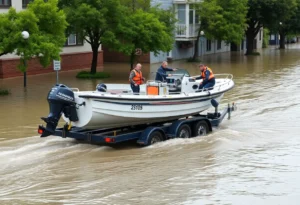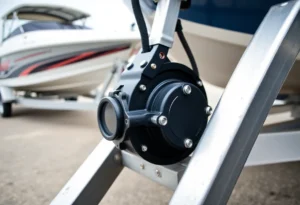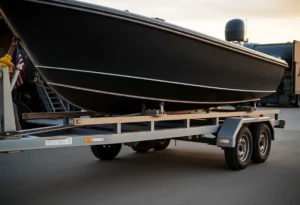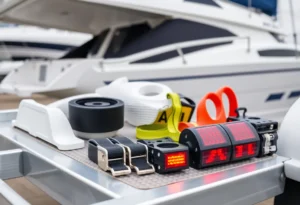When preparing a rescue boat trailer for swift and organized emergency response, effective storage solutions for essential gear are critical. Proper compartmentalization and mounting options on your trailer can make all the difference in saving time during a high-stakes operation. Below, we explore tips for organizing compartments and installing mounts on a rescue boat trailer, ensuring that your emergency equipment is secure, accessible, and efficiently arranged.
1. Plan Your Layout Based on Access and Prioritization
One of the first steps in designing storage for a rescue boat trailer is to plan the layout based on priority and frequency of use. Start by identifying the equipment you need regularly and ensure these items are stored in accessible areas. For instance, first-aid kits, life vests, emergency lights, and flares should be placed in compartments that can be easily reached when unloading or loading the trailer. This will minimize response time during emergencies.
Consider placing critical equipment towards the rear of the trailer for quick reach, while less-used but essential items, such as spare parts or repair tools, can be positioned in compartments that are accessible but don’t need to be as prominently located.
2. Utilize Custom Compartments for Organized Storage
Custom compartments help keep your emergency equipment neatly organized, preventing clutter and reducing the chance of equipment shifting during transport. Look for trailers that offer flexible compartment options or customization to suit your specific needs.
For example, compartmentalized drawers for tools or smaller emergency items can keep them secure and prevent loss. Designate separate areas for specific types of gear—one drawer for medical supplies, another for rescue tools, and another for survival gear. This way, during a mission, you know exactly where everything is, making it easy to grab items without unnecessary searching.
3. Add Secure Mounts and Holders for Large Gear
For larger equipment such as life rings, fire extinguishers, and oxygen tanks, it’s essential to have secure mounts and holders on your trailer. This prevents these items from moving around and getting damaged. Look for adjustable brackets or holders designed specifically for rescue or marine gear, as these can handle the size and weight of emergency equipment more effectively.
Consider also installing mounts with quick-release mechanisms, enabling fast retrieval of essential items. Ensure these mounts are sturdy enough to handle rough terrain and high speeds, so your equipment stays in place during transportation.
4. Install Waterproof Storage for Sensitive Equipment
Rescue operations often involve water exposure, so it’s essential to have waterproof compartments for sensitive electronics or paper documents. Items like communication devices, navigation charts, and even medical supplies can be damaged if exposed to moisture. Use waterproof storage solutions like sealed compartments or cases to keep these items dry.
For added protection, label these waterproof compartments to ensure they’re only used for water-sensitive items. This will help your team stay organized and prevent accidental exposure.
5. Optimize Space with Overhead and Side Mounts
Using overhead storage and side mounts can significantly increase the storage capacity of your trailer without taking up valuable floor space. Mounting options along the sides or overhead racks can hold items such as ropes, rescue poles, and even smaller inflatable gear that doesn’t require compartmentalized storage.
Side mounts are especially useful for securing items that may need to be accessed quickly, like fire extinguishers or flashlights. Overhead mounts, meanwhile, are perfect for lightweight, bulkier items like flotation devices or life jackets. These additional storage areas allow you to maximize space efficiently, making sure everything has a place and can be reached when needed.
6. Label Each Compartment for Quick Identification
In emergency situations, time is of the essence, and having clearly labeled compartments can speed up equipment retrieval. Use weather-resistant labels to mark each compartment based on its contents—”Medical Supplies,” “Navigation,” “Rescue Tools,” etc. This labeling system helps all personnel quickly identify and access the necessary items, regardless of who packed the trailer.
Color-coding can be another effective way to differentiate between types of equipment, such as using red for medical supplies and blue for safety equipment. This visual organization is especially helpful for larger teams, where not everyone may be familiar with the trailer’s layout.
7. Conduct Routine Inventory Checks and Maintenance
Lastly, keep the storage system functioning optimally with regular inventory checks and maintenance. Ensure all items are accounted for and in good working condition, and replace any equipment that’s damaged or expired. Perform monthly checks on mounts and compartments to confirm they’re secure and make any necessary adjustments to prevent loosening over time. Routine maintenance not only extends the life of your equipment but also ensures you’re always prepared for any rescue situation.
By implementing these strategies, you can create an organized, reliable, and highly efficient rescue boat trailer setup. The right storage solutions provide quick access to emergency equipment, reduce the risk of damage during transport, and ultimately support fast, effective response in critical situations. Prioritizing storage layout, adding secure mounts, and conducting regular checks will help your team maintain a high level of readiness on every mission.






